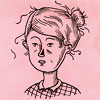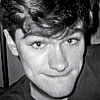 |
Chicago was a boggy mess in 1855. To stave off disease and make room for sewers and gas and water mains, city planners decided to elevate the street level. In Raising Chicago, the illustrator Lilli Carré (self-portrait at left) depicts the story of lifting the city’s early buildings out of the swamp. “[It] was a pretty incredible and bizarre moment in Chicago history,” she says. She researched photographs at the Chicago History Museum and read accounts of the operation to visualize it and tell the story graphically. Raising Chicago is her first nonfiction comic. “I got to flex different muscles and approach making a comic from a very different angle,” she says. “I don’t have any more public-works comics in mind, but maybe I’ll do another one or two or three someday.” Carré has published three books—Tales of Woodsman Pete, The Lagoon, and Nine Ways to Disappear—and her work appears in The Believer.
 |
For When Faith Meets Hard Times, his story about the recession’s effect on the Amish community in downstate Arthur, BRENDAN PELSUE practiced old-fashioned shoe-leather journalism. The modern reporter’s standbys of cell phone calls and e-mail messages weren’t helpful. “It’s a funny thing—if you’re far away from Arthur, it’s very hard to reach people. Once you’re there, it’s very easy,” he says. Even when potential interviewees weren’t at work or at home, someone always knew where they had gone. Although the Amish are more integrated into modern society than most people know, they still live in a world apart. “You really notice it when you drive in and out,” Pelsue says. “Clothing on the clothesline and houses with horses and buggies out front.”
Now a resident of Santa Monica, California, the standup comic ROBERT BUSCEMI revisited the Chicago comedy scene for “Top Dog,” his profile of the local comedian Prescott Tolk in Arena. “He has his finger on the pulse of Chicago standup,” Buscemi says. During his days in Chicago, Buscemi came to admire Tolk, especially for his ability to host open mics. “Once in a while, you’ll get a real nutball. Really misogynistic, or racist, even,” Buscemi says. “[Tolk] is really good at lowering the boom. He’s a much tougher guy than you think.” Buscemi recently released a new CD, Palpable—”possibly the best thing I’ve ever done,” he says—and he has a Chicago show August 8th at The Annoyance Theatre & Bar.
Writing her Adult Education article “Student Visa” for Chicago was something of a return for NINA KOKOTAS HAHN, who interned in the magazine’s editorial department 13 years ago. “I was very nervous when I worked there,” says Hahn, now a writer and an editor for Orbitz. Hahn identified eight fall classes in the area that each give students a taste of the exotic. While speaking to instructors, she collected a few facts from the curricula that lodged in her memory, such as how to pronounce “bruschetta” like a real Italian. “The best part comes in all the little bits of stickiness,” she says. And she’s willing to follow her own advice—she is planning to take one of her recommended courses, The Essentials of Buddhism in Plain English.
 |
While shooting pictures in Arthur, Illinois, for When Faith Meets Hard Times, DANIEL SHEA encountered a fundamental problem. “Most Amish object to being photographed directly. I had to be a little inventive,” he says. Some allowed him to take pictures only of their backs or their children, and Shea found great examples of what he calls “environmental portraiture,” shots of landscapes and distant buildings. Other such portraits already feature in his ongoing project Plume, about Appalachia and the coal industry. “I love traveling to places like this, spending time in remote communities,” he says of his trip downstate. “The culture there is inspiring. It’s incredibly efficient.”
Illustration: Lilli Carré
Photography: (Pelsue) courtesy of Brendan Pelsue, (Shea) Adam Golfer


